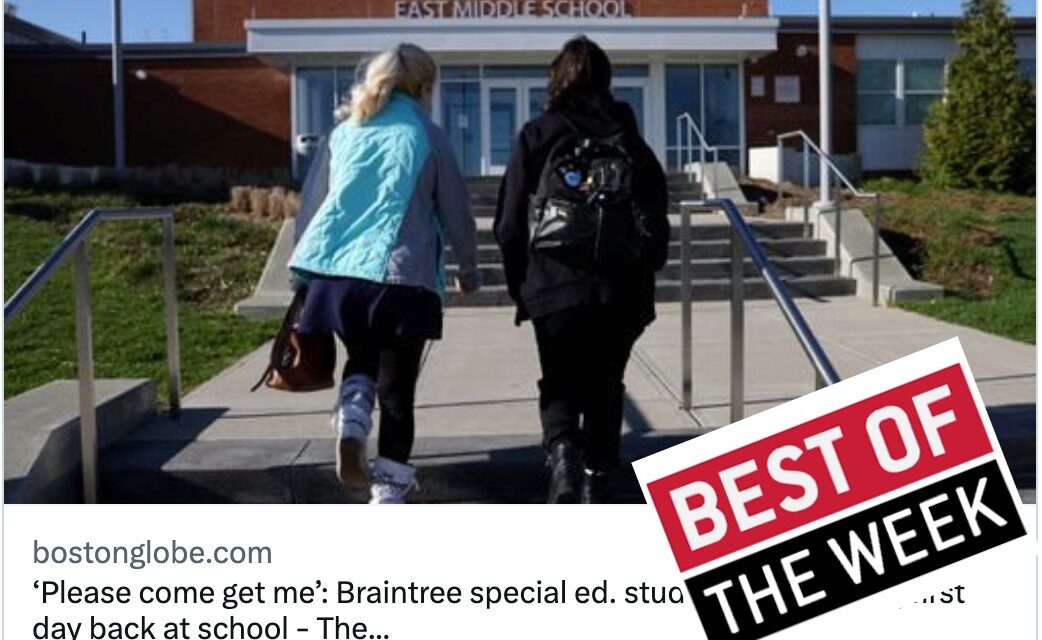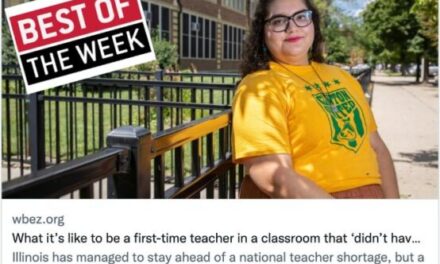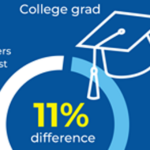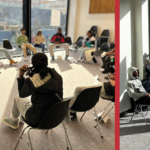📌 This edition includes some items that go back as far as April 12, since we were off last week. 📌
In this week’s newsletter: Student journalists critique national campus protest coverage. A district forces a special needs student to change schools. A public education advocate and I debate what ails school politics coverage. The U.S. News school rankings generate calls for context. Three ed-related projects win Peabody Award nominations. And high school journalists in Kansas shut down their district’s spyware.
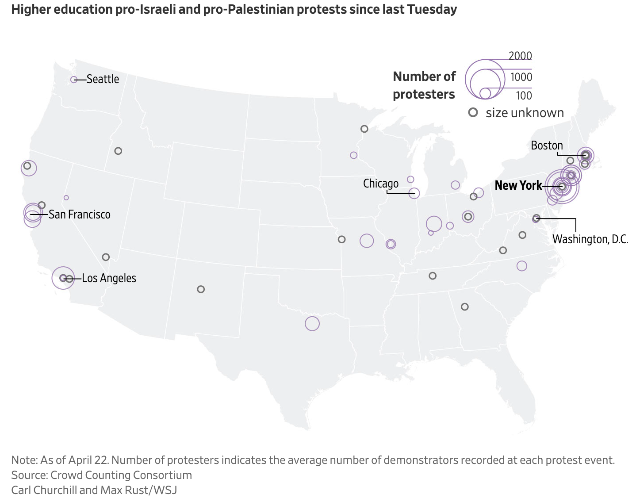
Above: The Wall Street Journal is tracking the spread of pro-Israeli and pro-Palestinian protests at college campuses.
PROTEST COVERAGE PROBLEMS
The big story of the week
Starting at Columbia University last week, protests against the Israel-Gaza war and investments in Israel have spread to college and university campuses across the U.S. (Wall Street Journal, CNN, USA Today, NPR, AP). Several hundred pro-Palestinian protesters have been arrested, including students and faculty members (Wall Street Journal, AP, Washington Post).
News outlets are singing the praises of the student journalists covering their own campuses, in particular the Columbia Daily Spectator (The Daily Beast, Poynter, The Objective).
However, there’s a long tradition of national news outlets botching coverage of colleges and universities, whether it’s political protests or allegations of sexual assault. As a student newspaper editor during the 2006 Duke lacrosse scandal, Atavist editor-in-chief Seyward Darby notes that her dominant recollection of the experience is “how awful and off-the-mark” most of the professional media covering it was.
And in the case of Columbia, student journalists aren’t necessarily returning the compliments they’re receiving. Spectator editors spoke to the Columbia Journalism Review about some nuances of the protests that the national media is missing.
“There have been protests outside of the gates that have brought many people from across the city to Columbia’s campus,” managing editor Esha Karam said. “I think the distinction is not always so clear in the national reporting that I’ve seen, what the difference is between the outside versus the inside.”
“It is so crucial to avoid overgeneralizations — the temptation to say that this one particular incident reflects either group involved,” said editor-in-chief Isabella Ramírez, who was also on CNN this week.
At Columbia and elsewhere, I wish the national media would take care to put these protests in context. So far, most of the protests have been peaceful, and many of the most contentious situations have been restricted to elite four-year universities. Once again, too many national news outlets are focusing on elite outliers, amplifying conflict, and — most worrisome — letting themselves be used by political actors seeking to discredit their opponents.
Check out daily links from @thegrade_ for other big education stories of the week including more school closures and consolidations, the closing of the case against the Stanford math education professor known for her advocacy to end tracking, and the Maryland educator who created a deepfake audio tape to disgrace a fellow educator.
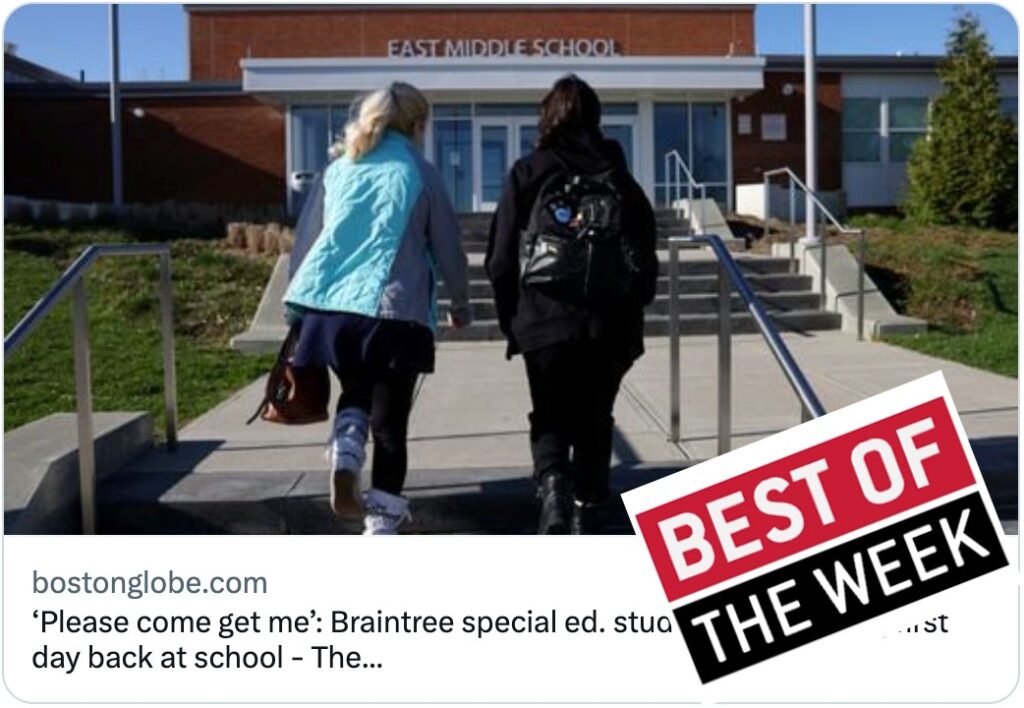
COURT-ORDERED SCHOOL ANXIETY
The best education journalism of the week
The best education journalism of the week is Monday was grueling but Tuesday was worse for Braintree student by The Boston Globe’s Mandy McLaren (with photos by Jessica Rinaldi).
The piece follows Samantha Frechon, a 14-year-old with autism and crippling anxiety, on her first and second days back to school in nearly a year after a court ordered her to attend a Braintree middle school rather than the specialized, one-on-one private school where she had been thriving, according to her family.
The first day goes badly. The second day is even worse. The raw emotion and intricate dynamics McLaren describes — Samantha’s desperate phone calls, her immigrant mother yelling at the police who’ve been sent by the school — are what make this so good. Samantha barely makes it through the front door before anxiety kicks in and she wants to go home. And McClaren is there to detail the process.
McLaren is a master of detail, offering a vivid personal account of the kind of conflict that plays out every day in schools nationwide, as students’ special needs pit parents and courts against school personnel and policies. It offers an unforgettable example of how funding shapes kids’ experiences. And it all comes on deadline, as the events unfolded just last Monday and Tuesday. The story is part of the Globe’s broader coverage of this and other “out-of-district” schooling placements for special education students.
Other education journalism we liked this week: one school’s response to the FAFSA fiasco (Chronicle of Higher Ed), the challenges Latino students in Arizona face (palabra), a look at a new team teaching model (Detroit Free Press), schools that have revamped math without generating outrage (Hechinger Report), and the challenges and benefits of Denver schools receiving migrant students (Hechinger Report). How about you?
DEBATING EDUCATION NEWS
Our latest columns and commentary
What happens when education reporters write about politics (and vice versa)? The results are often troubling.
In this week’s new column from us, public education advocate Jennifer Berkshire and I debate what ails school culture wars and education politics coverage — and how to fix it.
“Education journalists aren’t all that comfortable writing about politics while the folks who cover politics don’t know anything about education,” according to Berkshire. And so “we end up with a whole lot of school culture war stories that generate more heat than light.”
My view is that school politics coverage — book bans, school safety, etc. — has often been simplistic and exaggerated. But it’s not just because education reporters don’t know how to report on politics.
The amplification of conflict and drama are built into the process.
PEOPLE, JOBS, & EVENTS
Who’s going where and what’s happening

Above: Congrats to the newly announced Institute for Citizens and Scholars Higher Education Media Fellows, including former The Grade editor Karin Klein and Community College of Baltimore County journalism professor Beth Baunoch. I’m excited to see what stories they pursue.
📰 Awards: The Washington Post podcast “Surviving to Graduation;” the PBS, Future Investigates, and Texas Tribune collaboration “After Uvalde: Guns, Grief and Texas Politics;” and iHeart Podcasts’ “Unreformed: the Story of the Alabama Industrial School for Negro Children” have been nominated for the Peabody Awards. Business Insider’s Matt Drange, who talked to The Grade for a recent Q&A, was named a Livingston Award finalist for his coverage of sexual predators at schools. So was Daniel Huang for his New York Magazine story about efforts to integrate an Appalachian school district. The New York Times’ Hannah Dreier won Harvard’s 2023 Worth Bingham Prize for Investigative Journalism for her stunning series about exploited migrant kids in the labor force. NBC News’ Mike Hixenbaugh and Antonia Hylton were co-winners of the Nyhan Prize for Political Journalism. And the Houston Chronicle education team got some kudos from the Texas Managing Editors for their coverage of the HISD takeover.
📰 Career moves: Report for America announced its newest cohort of corps members, and with it, more than 20 reporters will be on beats covering education and children. Among the newest members are former AZ Republic education reporter Yana Kunichoff, who will be covering community resilience for AZLuminaria, and WLRN education reporter Kate Payne, who will be reporting on state government with a focus on education for the AP. CalMatters is taking over The Markup, and with the merger, they should have a stellar K-12 education team that includes Carolyn Jones and Tara García Mathewson. The Seattle Times’ newest K-12 reporter is Denisa Superville, who previously reported for EdWeek. And former EWA executive director Caroline Hendrie has a new gig as the executive director of SPJ and the SPJ Foundation. Congrats to all!
📰 Sound off:
- “Are you an education reporter facing a request from your newsroom to write a ‘top schools’ story?” asked the Detroit Free Press’s Lily Altavena about the U.S. News rankings that just came out. “Remember to cover rankings critically, writing about methodology, critiques and looking at whether these rankings favor wealthier, whiter areas.”
- “There was certainly a tendency to focus on teacher dismissals and the political implications,” Tim Daly tells us about media coverage of the 2010s teacher evaluation reform he recently revisited in a three-part series. “It would have been interesting to see more follow-up on what districts and states did when they paused or jettisoned their next generation evaluations… Did they work? Are teachers happier? Feeling better supported?”
📰 Conferences: Don’t miss IRE 2024 in Anaheim, California, this June. I spot several education-related sessions, including data and records requests on the education beat, investigating sexual abuse in public schools, what to cover in education, and investigating campus sexual assault. Register here.
THE KICKER
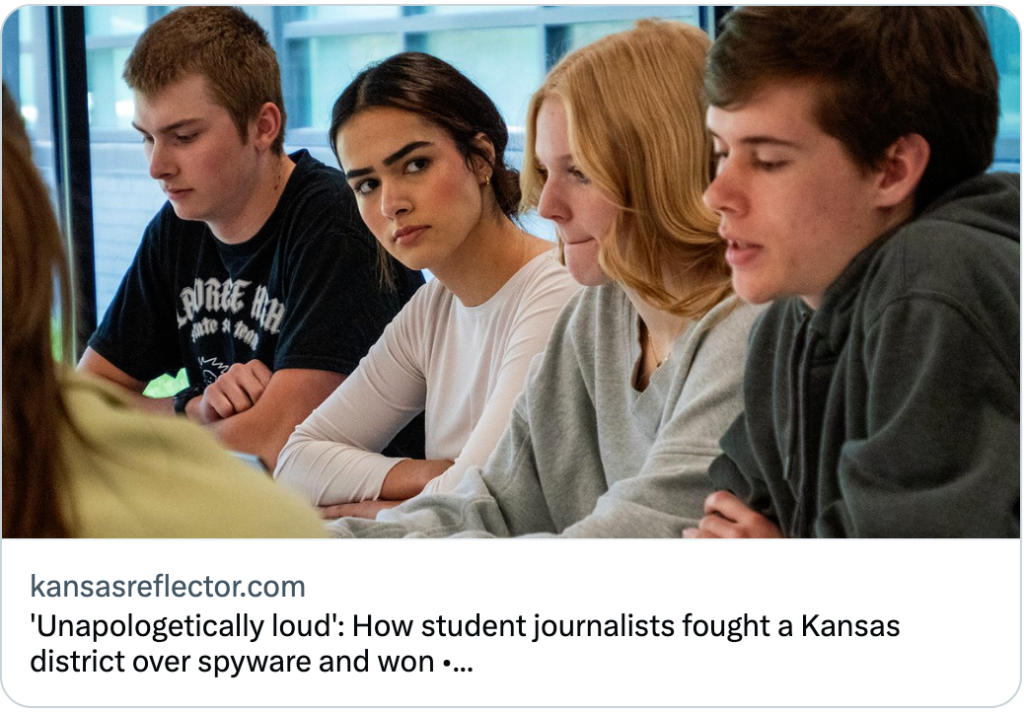
“All four of us are unapologetically loud,” said one of the high school journalists in Lawrence, Kansas, who, according to the Kansas Reflector, fought their school district over spyware and First Amendment violations — and won.
That’s all, folks. Thanks for reading!
Reply to this email to send us questions, comments or tips. Know someone else who should be reading Best of the Week? Send them this link to sign up.
Using Feedly or FlipBoard or any other kind of news reader? You can subscribe to The Grade’s “feed” by plugging in this web address: http://www.kappanonline.org/category/the-grade/feed/.
Read more about The Grade here. You can read all the back issues of The Grade’s newsletter, Best of the Week, here.
By Alexander Russo with additional writing from Colleen Connolly.


